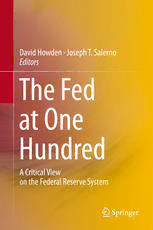
The Fed at One Hundred: A Critical View on the Federal Reserve System PDF
Preview The Fed at One Hundred: A Critical View on the Federal Reserve System
David Howden · Joseph T. Salerno Editors The Fed at One Hundred A Critical View on the Federal Reserve System The Fed at One Hundred ThiSisaFMBlankPage David Howden (cid:129) Joseph T. Salerno Editors The Fed at One Hundred A Critical View on the Federal Reserve System Editors DavidHowden JosephT.Salerno BusinessandEconomics PaceUniversity St.LouisUniversityMadridCampus LubinSchoolofBusiness Madrid NewYork,NewYork Spain USA ISBN978-3-319-06214-3 ISBN978-3-319-06215-0(eBook) DOI10.1007/978-3-319-06215-0 SpringerChamHeidelbergNewYorkDordrechtLondon LibraryofCongressControlNumber:2014943916 ©SpringerInternationalPublishingSwitzerland2014 Thisworkissubjecttocopyright.AllrightsarereservedbythePublisher,whetherthewholeorpart of the material is concerned, specifically the rights of translation, reprinting, reuse of illustrations, recitation,broadcasting,reproductiononmicrofilmsorinanyotherphysicalway,andtransmissionor informationstorageandretrieval,electronicadaptation,computersoftware,orbysimilarordissimilar methodologynowknownorhereafterdeveloped.Exemptedfromthislegalreservationarebriefexcerpts inconnectionwithreviewsorscholarlyanalysisormaterialsuppliedspecificallyforthepurposeofbeing enteredandexecutedonacomputersystem,forexclusiveusebythepurchaserofthework.Duplication ofthispublicationorpartsthereofispermittedonlyundertheprovisionsoftheCopyrightLawofthe Publisher’s location, in its current version, and permission for use must always be obtained from Springer.PermissionsforusemaybeobtainedthroughRightsLinkattheCopyrightClearanceCenter. ViolationsareliabletoprosecutionundertherespectiveCopyrightLaw. The use of general descriptive names, registered names, trademarks, service marks, etc. in this publicationdoesnotimply,evenintheabsenceofaspecificstatement,thatsuchnamesareexempt fromtherelevantprotectivelawsandregulationsandthereforefreeforgeneraluse. While the advice and information in this book are believed to be true and accurate at the date of publication,neithertheauthorsnortheeditorsnorthepublishercanacceptanylegalresponsibilityfor anyerrorsoromissionsthatmaybemade.Thepublishermakesnowarranty,expressorimplied,with respecttothematerialcontainedherein. Printedonacid-freepaper SpringerispartofSpringerScience+BusinessMedia(www.springer.com) Foreword TheUSFederalReserverecentlycelebratedits100thanniversary.Itisthereforea fittingmomenttoaskhowitisdoing. This indispensable book, edited by Professors David Howden and Joseph Salerno, and including contributions from a long list of distinguished scholars, bothasksthequestionandanswersitsimplyandauthoritatively:theFedhasbeena completefailure. At first glance this question and answer might seem primarily of interest to economists. But nothing could be further from the truth. What the Fed and other centralbanksdodeeplyaffectsthelivesofeveryone. IftheFedfails,ifmoreworryinglytheentirelineofthoughtthatledtotheFed provestobewrong,itisthemiddleclassandthepoorwhopaytheultimateprice. Overthecourseofthelastcentury,itisnoexaggerationtostatethatmillionshave lost their jobs because of the Fed. In prior decades, many of these people faced homelessness or even starvation. Even if homeless people rarely starve today in America,theconsequencesofbadeconomicpoliciesareincalculable. Fed failure is most obvious when it comes to economic crises and joblessness. Butthereisagreatdealofwishfulthinkingandmisinformationaboutthissubject. EconomicwriterJeffreyMadrickhasstated:“By1913,theUSfederalgovernment createdastablefinancialsystemwiththecreationoftheFederalReserve.” Economist Milton Friedman was more accurate when he wrote that: “The severity of each of the major economic contractions… is directly attributable to acts of … the Reserve authorities and would not have occurred under earlier monetaryandbankingarrangements.” Friedmanwrotethisin1962,yearsbeforetheFed-inducedgreatinflationofthe 1970sand theFed-induced bubblesthatled totheCrash of2008.Since 2008, the Fedhasembarkedonwhatwouldseemtobethequixotictaskoftryingtoprovethat moremoneyanddebtproducedbyitselfwillcureacrisiscreatedinthefirstplace bytoomuchmoneyanddebt. The Fed’s legislative mandate did not originally include employment levels. ThatwasaddedbyCongressin1977.Theinitialfocuswasonpricestability.Itwas v vi Foreword thought that stable prices and an elastic currency would eliminate the recessions anddepressionsoftheprecedingyears. The Fed did indeed bring us an elastic currency, which in practice just meant creatingmoreandmorenewmoney,butitdidnotbringusstableprices.Sincethe beginning of the Fed in 1914, the dollar has lost 97 % of its reported purchasing power. And there are reasons to think that the dollar has actually lost even more, especially since the Clinton administration, when the method of calculating con- sumerpriceinflationwasquietlychanged. PaulVolcker,generallyregardedasthemostsuccessfulofFedchairmen,stated in1994:“Iftheoverridingobjectiveispricestability,wedidabetterjobwiththe nineteenth century gold standard and passive central banks, …or even with ‘free banking’.” Uncontrollableconsumerpriceinflationissupposedtobeamystery,butthereis nothing mysterious about it. Thibault de Saint Phalle observed in 1985 that: “No oneinCongresseverpointsout…itistheFeditselfthatcreatesinflation.”Sowe havetheironyofaninstitutionchargedwithcontrollinginflationwhichhasinstead createdit. TodaytheFedhasgonepublicwithapolicyofdeliberatelyfosteringconsumer priceinflation,becausethisissupposedtohelptheeconomy.Nevermindthatthere isneitherevidencenorlogictosupportthisidea,andnevermindthatrisingprices mostdirectlypunishthemiddleclassandpoor. Thelegislatorswho passedtheFederalReserve Actin1913thoughttheywere creatinga“lenderoflastresort”runbybankers,notanationaleconomicplanning agencyrunbyanarrowgroupofeconomists.Butthelatteriswhatwehavetoday. Respected economic writer Jim Grant says about this: “Central planning may be discreditedinthebroadersense,butpeoplestillbelieveincentralplanningasitis practiced by…[the Fed]….To my mind the Fed is a cross between the late, unlamentedInterstateCommerceCommissionandtheWizardofOz.” EconomicwriterGeneCallahanaddsanimportantfurtherobservationwhenhe saysthatthechairmanoftheFed“istheheadpricefixerofapricefixingagency.” What he means is that the Fed’s main tool is control of the price of borrowed money, one of the biggest prices in the economy. Other central banks directly controlcurrencyprices,buttheUSFedchoosestoinfluenceratherthancontrolthe priceofthedollaroninternationalexchanges. Ironically,formerFedchairmanBenBernanketoldstudentsthat:“Pricesarethe thermostat of an economy. They are the mechanisms by which an economy functions.”Butpricescannotbeathermostatwhentheyarecontrolled. TheFedisnotonlylooseinitseconomicthinking.Itisalsolooseininterpreting itsownstatute.MuchofwhatitdidfollowingtheCrashof2008waslegal,butnot allofit.ThepurchaseofFannieMaeandFreddieMacsecuritiesviolatedtheclear languageofthelaw.UnfortunatelytheFedisneverheldtoaccount.Itoperatesin almostcompletesecrecyandevenpaysforitselfbycreatingmoneyoutofthinair. There is much, much more to be said, and it is all covered by this wonderful book. Individual chapters range from the history of the Fed, including the unnec- essarytragediesoftheGreatDepressionandCrashof2008,tohowtheFedoperates Foreword vii behinditscloseddoors,andwhatitmeansfortheeconomy.Importantly,ittellsus what a better monetary system would look like, a monetary system that could launchusonanewandhithertounknowneraofprosperity. Thisisabookforanyone,notjustscholars.Itcouldalsobeusedasanexcellent introduction to economics or as an adjunct to an economic textbook for students. After seeing firsthand, in these pages, how critical right economic thinking and policyareforourlives,anyonewouldwanttodelvemoredeeplyintothesubject. Charlottesville,Virginia HunterLewis ThiSisaFMBlankPage Contents Introduction. . . . . . . . . . . . . . . . . . . . . . . . . . . . . . . . . . . . . . . . . . . . . . 1 DavidHowdenandJosephT.Salerno APre-historyoftheFederalReserve. . . . . . . . . . . . . . . . . . . . . . . . . . . 9 DavidHowden DoesU.S.HistoryVindicateCentralBanking?. . . . . . . . . . . . . . . . . . . 23 ThomasE.WoodsJr BenBernanke,TheFDRofCentralBankers. . . . . . . . . . . . . . . . . . . . . 31 RobertP.Murphy FedPolicyErrorsoftheGreatDepression. . . . . . . . . . . . . . . . . . . . . . . 43 JeffreyHerbener TheFederalReserve:RealityTrumpsRhetoric. . . . . . . . . . . . . . . . . . . 55 ShawnRitenour AFraudulentLegend:TheMythoftheIndependentFed. . . . . . . . . . . 65 ThomasDiLorenzo WillGoldPlatingtheFedProvideaSoundDollar?. . . . . . . . . . . . . . . . 75 JosephT.Salerno ArthurBurns:ThePh.D.StandardBeginsandtheEndof Independence. . . . . . . . . . . . . . . . . . . . . . . . . . . . . . . . . . . . . . . . . . . . . 91 DouglasFrench TheFederalReserve’sHousingBubbleandthe SkyscraperCurse. . . . . . . . . . . . . . . . . . . . . . . . . . . . . . . . . . . . . . . . . . 103 MarkThornton ThereIsNoAccountingfortheFed. . . . . . . . . . . . . . . . . . . . . . . . . . . . 115 WilliamBarnettII ix
